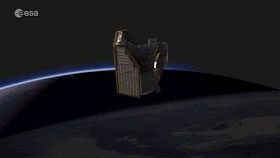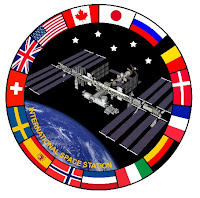ISS - Expedition 63 Mission patch.
Sept. 4, 2020
The week of August 31, crew members aboard the International Space Station conducted scientific studies on monitoring spacecraft air, autonomous robots, and predicting spacecraft charging events.
Image above: NASA astronaut Chris Cassidy works inside the space station's Zvezda service module preparing for an event commemorating Russian space activities. Image Credit: NASA.
Now in its 20th year of continuous human presence, the space station provides a platform for long-duration research in microgravity and for learning to live and work in space. Experience gained on the orbiting lab supports Artemis, NASA’s program to go forward to the Moon and on to Mars.
Here are details on some of the microgravity investigations currently taking place:
Something is in the air
Spacecraft Atmosphere Monitor (SAM) demonstrates a small device known as a gas chromatograph mass spectrometer. It measures trace organic compounds such as nitrogen, oxygen, carbon dioxide, and water in space station air. The instrument uses little power and its regular transmission of data to the ground research team eliminates the need to return air samples to Earth for analysis. During the week, the crew powered off SAM and installed the Major Constituent Analyzer (MCA) plug, which is used to protect the sensor when the unit is off.
Image above: Taken as the International Space Station orbited above the border between Bolivia and Brazil, this image shows wildfires in the Amazon rainforest. Image Credit: NASA.
Autonomous airborne assistants
Astrobee tests three free-flying, cube-shaped robots designed to help scientists and engineers develop and test technologies including computer vision, robotic manipulation, control algorithms, and human-robot interactions. Cameras and sensors on the devices could be used to assist with routine chores and perform crew monitoring, scientific sampling, and logistics management, freeing up crew time for other science and engineering duties. Astrobee also gives ground controllers additional eyes and ears on the space station and can be operated remotely from the ground. During the week, crew members powered up the robots and performed various testing operations.
An early warning system for spacecraft charging
Image above: The Space Test Program-Houston 6 (STP-H6) payload can be seen atop of the EXPRESS Logistics Carrier-3 (ELC-3) at the far left of this image of NASA astronaut Andrew Morgan and ESA (European Space Agency) astronaut Luca Parmitano during a spacewalk in January 2020. Image Credit: NASA.
The Space Test Program-Houston 6-Spacecraft PlasmA Diagnostic suitE (STP-H6-SPADE) investigation monitors the interaction between the space station and the environment along its orbit. These interactions include hazardous charging events; these occur when a negative charge builds up on the outside of a spacecraft and can cause operational anomalies and satellite failures. SPADE senses key features of the spacecraft’s environment to provide early warning of dangerous charging and more accurately predict effects on satellite operations. Increasing reliance on satellites for many day-to-day operations creates a need to predict space conditions in much the way we forecast the daily weather. SPADE is one of a number of investigations that rely on automation and so require little or no crew involvement, increasing how many scientific investigations can be conducted on the orbiting lab.
Other investigations on which the crew performed work:
- Radi-N2, a Canadian Space Agency investigation, uses bubble detectors to better characterize the neutron environment on the space station, helping to define the risk it poses to crew members.
https://www.nasa.gov/mission_pages/station/research/experiments/explorer/Investigation.html?#id=874
- Crew members photograph Earth using digital handheld cameras for Crew Earth Observations (CEO). Photographs recording human-caused changes such as urban growth and reservoir construction and natural dynamic events including hurricanes and volcanic eruptions are publically available at the Gateway to Astronaut Photography of Earth.
https://www.nasa.gov/mission_pages/station/research/experiments/explorer/Investigation.html?#id=84
- ISS Ham Radio gives students an opportunity to talk directly with crew members via ham radio when the space station passes over their schools. This interaction engages and educates students, teachers, parents and other members of the community in science, technology, engineering, and math.
https://www.nasa.gov/mission_pages/station/research/experiments/explorer/Investigation.html?#id=337
Space to Ground: Following Chris: 09/04/2020
Related links:
Expedition 63: https://www.nasa.gov/mission_pages/station/expeditions/expedition63/index.html
Gateway to Astronaut Photography of Earth: https://eol.jsc.nasa.gov/
Spacecraft Atmosphere Monitor (SAM): https://www.nasa.gov/mission_pages/station/research/experiments/explorer/Investigation.html?#id=1843
Astrobee: https://www.nasa.gov/mission_pages/station/research/experiments/explorer/Facility.html?#id=1891
STP-H6-SPADE: https://www.nasa.gov/mission_pages/station/research/experiments/explorer/Investigation.html?#id=8005
Crew involvement: https://www.nasa.gov/mission_pages/station/research/news/research-aboard-iss-continues-with-nasa-astronaut-chris-cassidy
ISS National Lab: https://www.issnationallab.org/
Spot the Station: https://spotthestation.nasa.gov/
Space Station Research and Technology: https://www.nasa.gov/mission_pages/station/research/overview.html
International Space Station (ISS): https://www.nasa.gov/mission_pages/station/main/index.html
Images (mentioned), Video (NASA), Text, Credits: NASA/Michael Johnson/John Love, ISS Research Planning Integration Scientist Expedition 63.
Best regards, Orbiter.ch














































